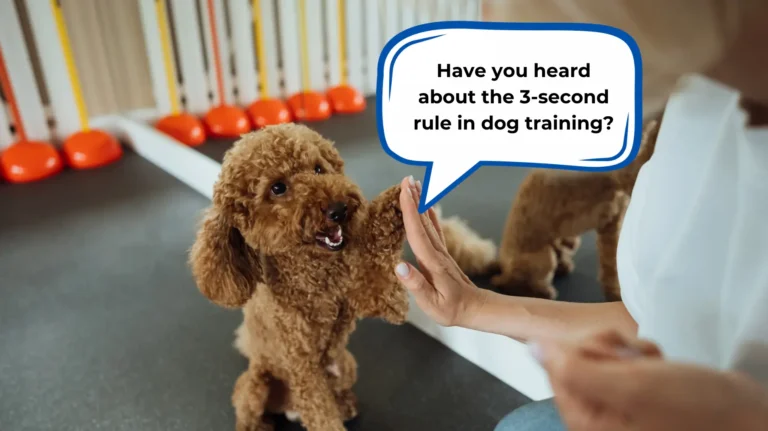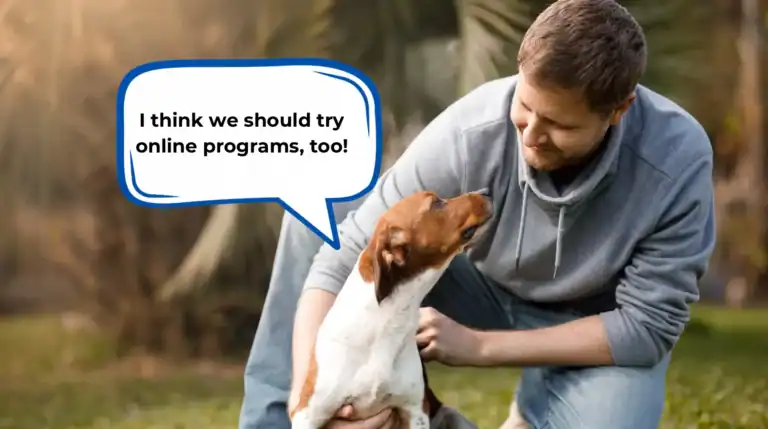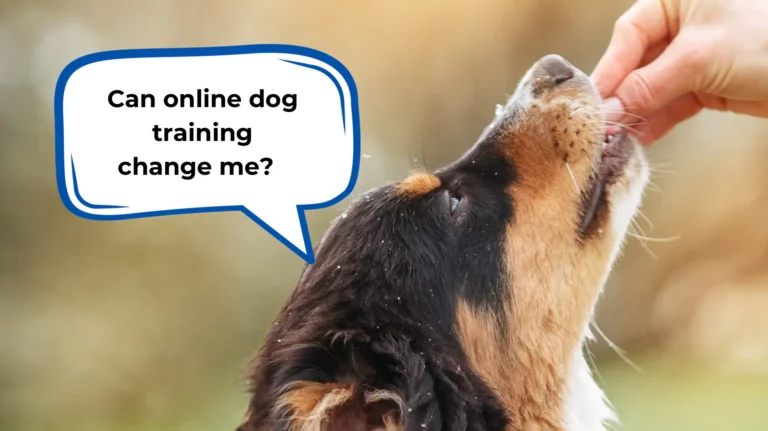A dog who lunges is a dog that must be trained… fast. In this blog, I share the best strategies how to stop dog from lunging at other dogs and you.
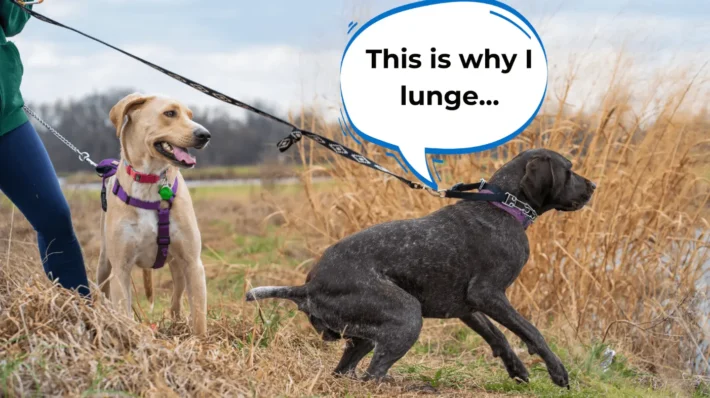
What is dog lunging?
You can pinpoint this issue when your dog suddenly reacts with lunges and hyperactivity while on a leash. One moment, you could be walking with them calmly, and the next thing you know, they're already rushing forward and pulling hard on the leash trying to get somewhere in a hurry.
There are multiple reasons for dogs lunging: it could be out of excitement, fear, anxiety, or territorial behavior. What I want dog owners to understand is that dog lunging can't be corrected by just treats or force.
To solve dog lunging, you have to investigate the root cause, change your training plan, and be creative about letting your dog understand there's really no reason for them to react and lunge.
Read on to learn more.
Key Takeaways
- Dog lunging has multiple root causes: It's not a one-size-fits-all behavior. Lunging can stem from excitement, fear, anxiety, territorial instincts, or lack of training/socialization. Understanding the specific cause for your dog is crucial for practical training.
- Leadership and calm communication are critical: Dogs are pack animals who need clear guidance when it comes to barking and lunging. Establishing yourself as a quiet, confident leader through consistent training and clear communication helps your dog feel secure and less likely to lunge out of insecurity or fear.
- Training should focus on long-term solutions, not quick fixes. Treats and force might temporarily suppress lunging, but they don't address the root cause. For lasting change, focus on building leadership, desensitizing your dog to triggers, and teaching impulse control.
Table of Contents
FREE WEB CLASS TO REVERSE DOG REACTIVITY IN 7 DAYSWhat Dog Lunging Means
A lunging dog can be interpreted in two ways: they're so happy and excited (which is a good thing), or they're lunging because they feel threatened (which is not pleasant).
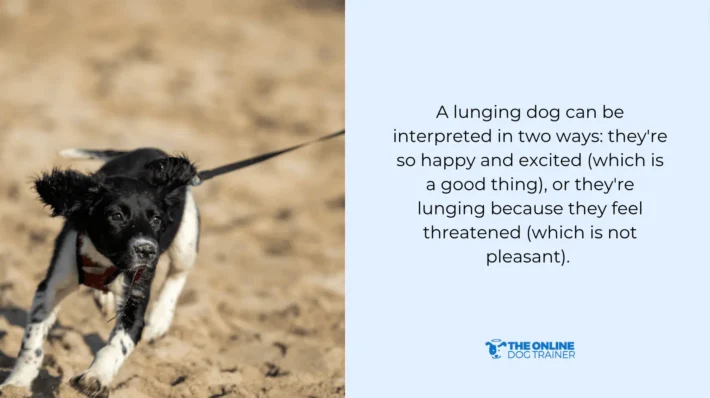
A Dog Lunge Can Be a Sign of Playfulness and Excitement
When a dog lunges towards other dogs, it could mean the following:
- They're excited
- They want to play
- They want to be closer to the other dogs.
They could also yelp and lunge at people because they love them and want to be affectionate. Lunging is also their way of saying, “I need to pee” or “I need to sniff that ball!”
A Dog Lunge Can Also Be an Attack or Defense
A lunge accompanied by growling, tense body language, or an aggressive stance signifies displeasure. Dogs lunge when they're unhappy, threatened, scared, and fearful. The most important thing to do to stop your dog from lunging is to understand what's causing them to lunge.
Dog Behavior: What Causes a Dog to Lunge?
Reason #1: Over Excitement and Heightened Emotional State
Think of children at a party bouncing off the walls with unbridled energy. Their excitement levels are through the roof, constantly fluctuating between a seven and a ten on a scale of 1 to 10.

This heightened state makes them prone to overreacting to any additional stimulus. Similarly, dogs who are perpetually amped up, pulling on leashes with eyes wide and tongues lolling, are already operating at a high energy level. For a reactive dog, seeing another dog or any exciting trigger can quickly push them over the edge into adrenaline-fueled lunging.
FEEL PEACEFUL ON EVERY WALK—WATCH THE FREE DOG REACTIVITY WEBINAR NOWReason #2: Fear and Anxiety
On the flip side, fear and anxiety can also trigger lunging. Imagine someone watching a scary movie. The tension builds with each scene, priming them to react to even the slightest provocation.
Dogs experiencing fear or anxiety are in a similar state, their bodies tense and ready to snap at any perceived threat. A person approaching too closely, an overly playful dog at a dog park, or an unexpected noise can act as the final straw, leading to a defensive lunge.
Reason #3: Dog Lunges Because of Territorial Behavior
Territorial behavior can also manifest as lunging. Your canine companion is naturally protective of you and their perceived territory.
If they feel their space is being invaded, they may lunge as a warning to the intruder. This could happen when another dog approaches their owner on a leash or someone gets too close to their front door.
Reason #4: Lack of Training and Socialization to Other Dogs
Finally, a lack of training and socialization can contribute to lunging. Dogs who haven't been exposed to various stimuli may react fearfully or aggressively to unfamiliar objects or situations. Many dogs are anxious about socializing with others because they lack appropriate social experiences.
They haven't learned how to behave appropriately around strollers, cats, or people with umbrellas. This lunging can be addressed through patient and consistent training, gradually introducing the dog to new experiences in a calm and controlled environment.
STOP THE BARKING, LUNGING & STRESS—FREE WEBINAR SHOWS YOU HOW IN UNDER A WEEKReason #5: Leash Aggression
Leash aggression is a primary cause of dogs lunging. A leash-aggressive dog often feel trapped, unable to flee or greet freely, which can escalate their fear or frustration. This confined feeling often triggers a “fight” response, leading to sudden barking, growling, and lunging as they try to create distance. Recognizing this underlying stress is the first step in addressing the behavior.
How to Stop Dogs from Lunging: Loving Leadership
Before dog owners start training their dogs to overcome certain dog behaviors, I always remind them of the importance of loving leadership.
Dogs operate in packs, and therefore, they need a pack leader — this is how dog psychology works.
I have met dog owners that said “Well, I'm their owner. I'm automatically the one in charge, right?”
The answer is no. If you want your dog to see you as the leader, you have to take certain steps to ensure that. My bestselling online program, The Dog Calming Code™️, aims to teach dog owners to be the leader in their dog's eyes.
What's unique about The Dog Calming Code is it teaches leadership without shouting or using force. Instead, it helps dog owners use dog psychology to establish leadership.
Remember, seemingly insignificant things can make your dog feel they're in charge instead of you.
For example:
- If your dog has access to food anytime they want, whether you're giving it to them or they're eating scraps on the ground, they will think they're in charge.
- If your dog knows they can get your attention and affection whenever they ask for it, they will feel they're in charge.
- If you react strongly to your dog's call for warning, even if there's no real danger around, they will think they're in charge.
- If your dog decides where to go, where to potty, where to eat, you're communicating to them they're in charge.
- If you're out on the walk and you give in to your dog's tugging, lunging, and pulling, your dog will become the one in charge.
These things are easy to overlook , which is why most dog owners struggle to train dogs to behave better. The Five Golden Rules of Leadership taught in The Dog Calming Code will help you let your dog know: “Hey, I'm in charge, not you.”
If you have a dog who lunges all the time they're on the leash, you could have a dog who is stressed, anxious, or threatened because they've taken on the leadership role.
The good news is you can now learn about The Dog Calming Code through my free webinar on dog reactivity. It's totally free, but it's value-packed!
GET ACCESS TO DOGGY DAN'S BESTSELLING PROGRAM FOR FREEHow to Solve Dog Lunging: Tips From A Professional Dog Trainer
Establish Loving Leadership
Dogs are pack animals and thrive when they know their place in the hierarchy. They panic and become aggressive and anxious when they know they have to lead their pack (including you).
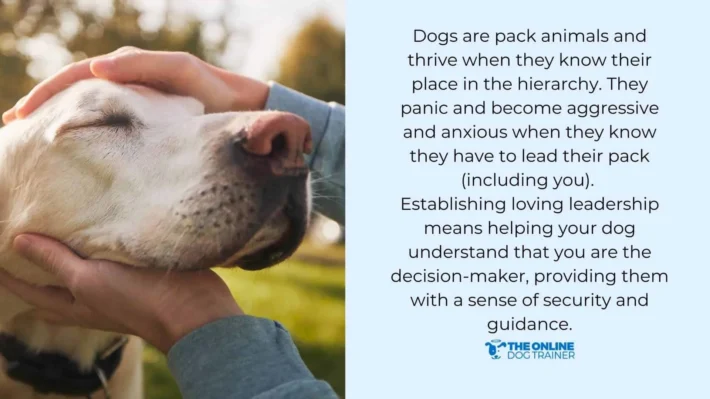
Establishing loving leadership means helping your dog understand that you are the decision-maker, providing them with a sense of security and guidance.
When your dog thinks they're the leader, what matters to them is the survival of their pack (you included). They take on the role as the protector. They want to ensure everyone is safe! This desire to protect causes them to always be anxious, scared, on guard, and unable to calm down.
Taking on the role of the leader from your dogs helps them know you're the protector, and that you're there with them to help them be safe. Your dog will feel you don't need to be protected all the time. They will stay calm because they know they're not the ones making all the survival decisions anymore.
Emphasize Leadership With Walk Exercises
I want each dog owner to understand that walking outdoors is synonymous with fighting for survival for your dog.
They're on the edge, on guard, and want to be safe. In your dog's head, they need to make the decisions because they think they know best how to survive. Reminding your dog of your role as their decision-maker and protector will help.
Specific walk exercises can reinforce your leadership role and help your dog understand their place during walks.
GET IMMEDIATE RELIEF: SOLVE YOUR DOG'S REACTIVITY CHALLENGES TODAYThe One Yard Walk
Start by taking one step out the front door, immediately turning your dog around, and walking back inside. This exercise helps your dog understand that you're in charge of the walk and make all the decisions. The dog will resist at first, but when they understands that you control the walk, they will learn fast.
Donut Walk
It's quick to lose control of the walk, especially when maneuvering the leash. By letting the dog go in front, you're already telling them they're in charge.
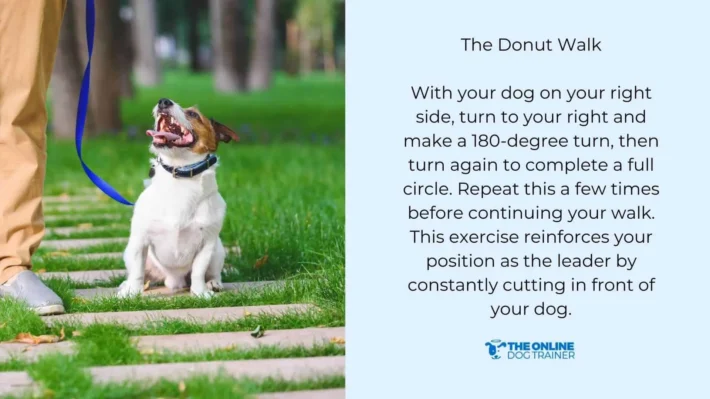
An exercise you can do to show your dog you're in charge is The Donut Walk.
With your dog on your right side, turn in a full circle to the right, then another full circle to the right. This means you've turned twice in front of your dog, establishing your leadership. By walking in front when changing direction, your dog learns to follow your lead and decisions.
Follow Consistent Training
Consistency is vital in dog and puppy training. Reinforce basic commands like “sit,” “stay,” and “heel” in your training classes to help your dog understand your expectations and improve their focus during walks.
Quick dog trainer tip: despite consistent training, there's a chance your own dog won't stop lunging immediately. Your dog's resistance to more progress isn't because the training plan doesn't work; your dog simply doesn't find a reason to obey you.
They still think they're the leader, so why should they listen to you?
I'd like to re-emphasize the power of leadership here. Once your dog knows you're the leader, they will listen to you and respect your leadership and capacity to make decisions for them. Training will be more effective.
THE ONLY CLASS YOU'LL EVER NEED TO SOLVE REACTIVITY ISSUESChoose the Right Leash
The right leash is essential for practical training. It's hard to control a dog with a leash you can't even control.
A short, fixed-length leash (about 1 foot long) provides better control and feedback than a long, elastic, or extendable leash.
Leash designs I don't recommend:
Overly long leashes
Too long leashes make it difficult to control your dog and encourage pulling. A shorter leash allows for better control and communication with your dog.
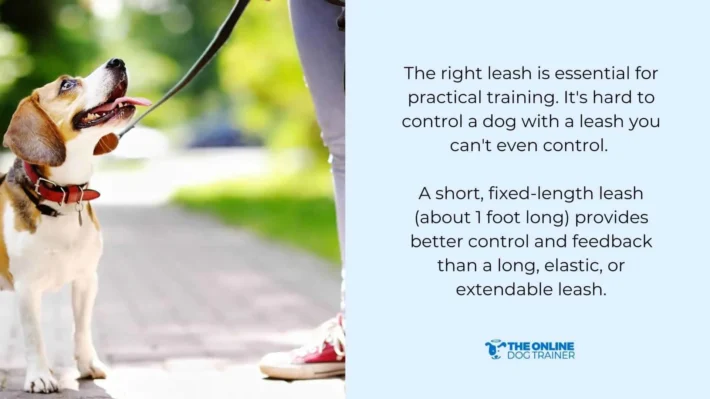
Leashes without adjustable length
Having the ability to adjust the length of your leash gives you more flexibility in different situations. Depending on the environment, a fixed-length leash might be too long or too short.
Spongy or elastic leashes
These leashes make it challenging to maintain a consistent connection with your dog. The give in the leash can create tension and encourage pulling, making it harder to teach your dog to walk nicely by your side.
Extendable leads
Similar to spongy leashes, extendable leads have a slight give, making it difficult to maintain control. Additionally, the sudden tightening of the leash can be jarring for both you and your dog.
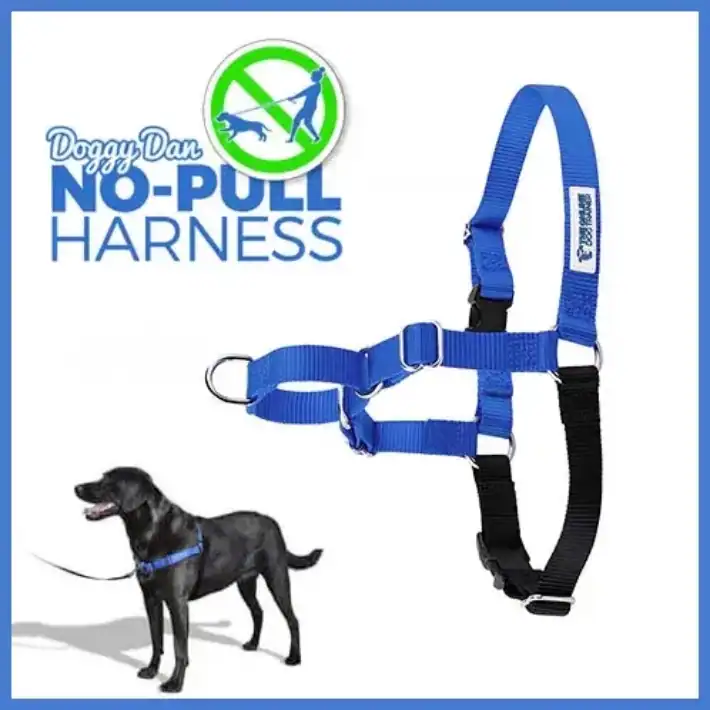
Looking at Harness and Collars
Choosing the right equipment is crucial. Avoid flat collars, head harnesses, and back clip harnesses, as they can cause discomfort or encourage pulling.
Instead, opt for a front-clip harness like the Doggy Dan No Pull Harness, which discourages pulling and promotes a calmer demeanor.
FREE WEBCLASS THAT GUARANTEES TO BRING BACK PEACE TO YOUR HOMEUse Correct Walking Exercises
Incorporate exercises into your walks to reinforce desired behaviors and discourage lunging. Here are some things you can do.
Exercise with Treats and Toys
Use treats and toys to reward your dog for staying calm and focused during walks. Use food rewards and toys strategically to redirect your dog's focus from its triggers to you.
Desensitization and Exposure
This technique involves gradually exposing your dog to triggers that usually cause them to lunge reactively. I've written a detailed blog post, “Seven Steps to Stopping Any Unwanted Behavior, “ which you might find helpful.
A crucial point here is to ensure you're rewarding your dog away from the trigger. Avoid giving treats when your dog is fixated on another dog and getting excited. I've seen many owners try to distract their dogs with treats while the dog is still focused on the trigger, but this only reinforces the excitement. Remember, a dog's energy follows their focus.
To reward calmness, first, get your dog's attention away from the trigger. You could use a tempting treat to lure them away or calmly guide them in another direction. Once you've created enough distance between your dog and the trigger, and they've calmed down, then you can reward them.
Watching Our Energy
Dogs are masters at reading our emotions. If you're stressed, anxious, or frustrated, your dog will pick up on it and may become more reactive. Practice relaxation techniques, maintain calm, and use a soothing voice when working with your dog.
No matter how much you tell them to calm down, your dog won't be able to obey your command or have a more relaxed body language if you're stressed.
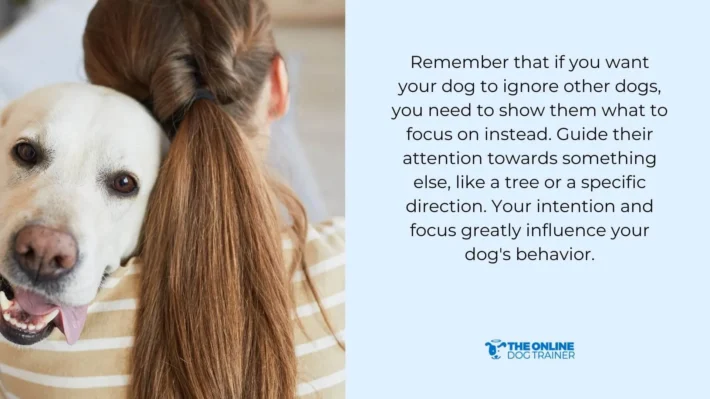
Remember that if you want your dog to ignore other dogs, you need to show them what to focus on instead. Guide their attention towards something else, like a tree or a specific direction. Your intention and focus greatly influence your dog's behavior.
Also, remember that less is more when it comes to communication. Stay calm and use fewer words, or even remain silent. Your actions, such as calmly turning your dog away, speak volumes. Even your breathing can have a calming effect on your dog.
JOIN THE FREE CLASS THAT CHANGED THE LIVES OF 100,000 DOGS!Impulse Control
Practice exercises that teach your dog to control their impulses.
For example, have them sit and wait before crossing the street or approaching another dog. This helps them develop self-control and patience.
Ask for Professional Help
Your dog's confidence and strength will continue to grow until they are about two years old. So, if you're facing challenges with your dog while they are young, it's crucial to address the issue promptly and seek professional help if needed.
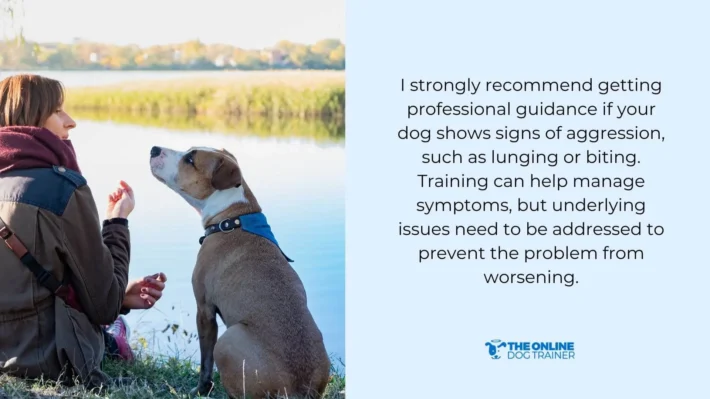
I strongly recommend getting professional guidance if your dog shows signs of aggression, such as lunging or biting. Training can help manage symptoms, but underlying issues need to be addressed to prevent the problem from worsening.
Understanding your dog's need for leadership and implementing a consistent structure is key to preventing and resolving behavioral issues. Even if your dog is older, establishing loving leadership and clear communication can make a significant difference.
I offer a free webinar on stopping dog reactivity without relying on food bribes or tricks. It's designed to teach you about loving leadership and address the root causes of reactivity, helping you prevent problems from escalating or even occurring in the first place. If you want a holistic approach to managing your dog's behavior, I encourage you to check it out.
THIS FREE WEBCLASS HELPS YOU END FRUSTRATING DOG AGGRESSION FAST!Good Leadership + Reliable Strategies Will Stop Dog Lunging
It can feel overwhelming when your dog lunges, but hang in there! You can stop this bad behavior.
It's key to stay consistent with training and monitor both your energy and your dog's stress levels. It's a journey with ups and downs, so remember to be patient and celebrate even the smallest victories.
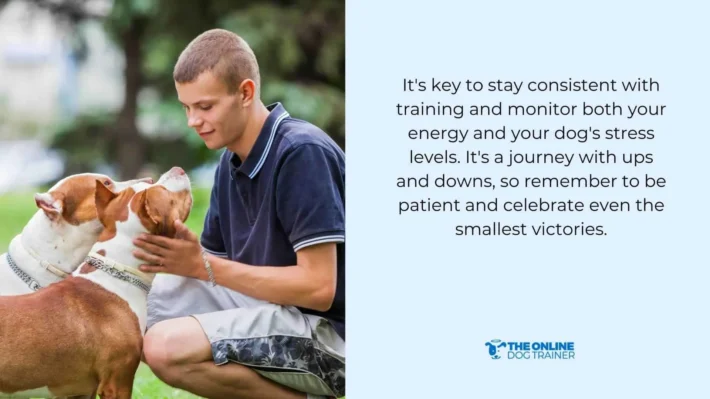
Dogs thrive with a calm, confident leader, and you can be that for your pup. By using the right tools and techniques and getting help from a professional when you need it, you can stop dog lunging and have calmer, more enjoyable walks. Tackle this lunging challenge and look forward to more peaceful walks together. Don't lose hope – you and your dog can overcome lunging issues!
I talk more about issues like this one in my FREE REACTIVITY WEBINAR. I hope to see you there!

~Doggy Dan




